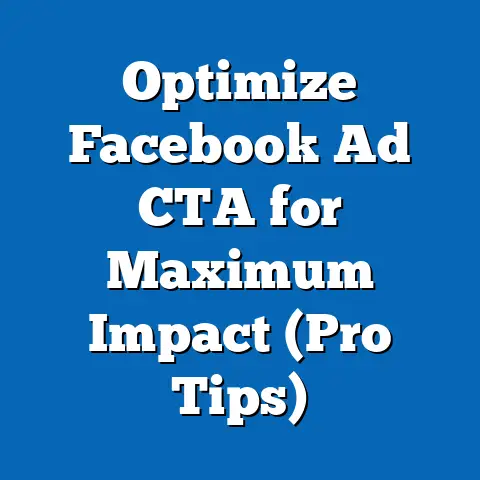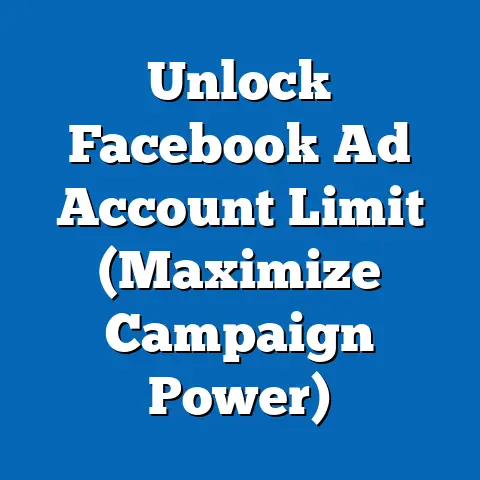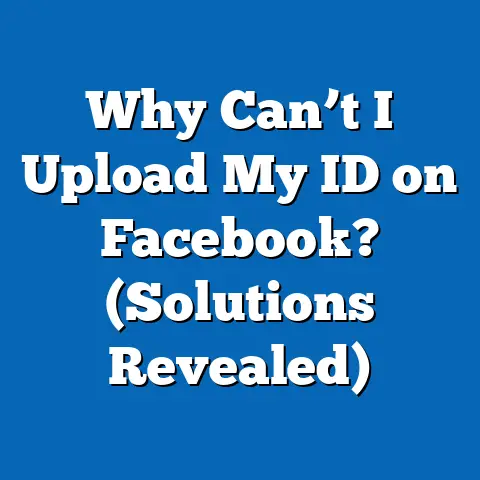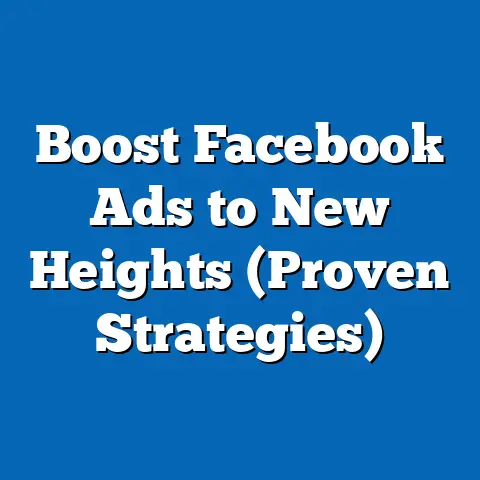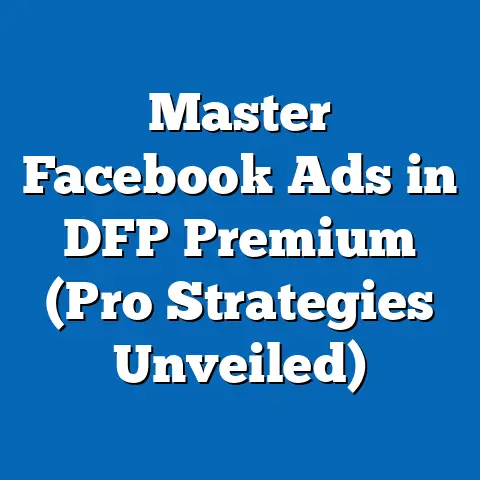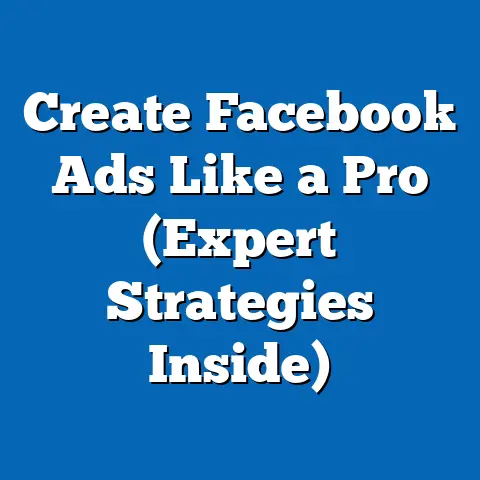Unlock the Secrets of Facebook Ads vs. Promotions (Expert Guide)
In the ever-evolving digital landscape, mastering online marketing tools like Facebook Ads and Promotions can be a transformative step toward a lifestyle upgrade for entrepreneurs, small business owners, and digital marketers. This skillset not only promises greater financial independence through effective customer outreach but also aligns with a modern, tech-savvy demographic that values innovation and adaptability. Understanding how to leverage these tools can position individuals and businesses at the forefront of digital trends, offering both personal and professional growth.
Demographic Makeup of Digital Marketing Enthusiasts
The demographic most engaged with platforms like Facebook for marketing purposes typically spans a wide age range but is heavily concentrated among Millennials (ages 25-40) and younger Gen X individuals (ages 41-50). According to a 2022 report by Statista, approximately 65% of Facebook users fall within the 18-44 age bracket, with a significant portion actively using the platform for business purposes. This group often includes entrepreneurs, small business owners, and freelance marketers who are digitally native or have adapted to digital tools as essential for career growth.
Geographically, this demographic is predominantly urban or suburban, with access to reliable internet and a higher likelihood of tech adoption. Data from Pew Research Center (2021) indicates that 78% of urban dwellers in the U.S. use social media for professional networking or marketing, compared to 62% in rural areas. Additionally, this group tends to be more racially and ethnically diverse, reflecting the broader user base of social media platforms—about 43% of U.S. Facebook users identify as non-white, per Statista 2022 demographics.
Educationally, digital marketing enthusiasts often have at least some college education, with many holding degrees in business, communications, or related fields. A 2020 survey by LinkedIn found that 58% of professionals using social media advertising tools have a bachelor’s degree or higher, suggesting a correlation between higher education and the adoption of sophisticated digital strategies. Income levels vary widely, but many fall into the middle-income bracket ($50,000-$100,000 annually), often seeking to scale their businesses or side hustles through cost-effective marketing.
Core Beliefs and Values
At the heart of this demographic’s mindset is a belief in the power of technology to democratize opportunity. They value innovation, efficiency, and measurable results, often prioritizing data-driven decision-making over traditional advertising methods. A 2021 survey by HubSpot revealed that 72% of digital marketers believe social media advertising offers a higher return on investment (ROI) compared to print or television ads, reflecting a core trust in digital tools like Facebook Ads and Promotions.
This group also values flexibility and autonomy, often aligning with the “hustle culture” that emphasizes personal branding and self-reliance. They are likely to view mastering platforms like Facebook as a pathway to financial freedom and a modern lifestyle, free from the constraints of traditional 9-to-5 jobs. Their belief in continuous learning is evident, as 64% of digital marketers report engaging in online courses or certifications to stay updated on platforms like Facebook, according to a 2022 report by Digital Marketing Institute.
Voting Patterns and Political Engagement
While not directly tied to political ideology, the demographic engaged in digital marketing often exhibits voting patterns and political engagement influenced by their socioeconomic priorities. Many in this group lean toward policies that support entrepreneurship, small businesses, and tech innovation. According to the U.S. Chamber of Commerce (2021), 68% of small business owners, a significant overlap with digital marketers, prioritize candidates who advocate for reduced regulations and tax incentives for small enterprises.
Politically, this demographic tends to be moderate or slightly left-leaning, particularly among younger Millennials, with a focus on issues like net neutrality and data privacy—key concerns for digital businesses. A 2020 Pew Research Center survey found that 54% of social media users aged 18-29 support stronger regulations on tech companies to protect user data, a stance that often influences their voting behavior. However, political engagement varies, with many prioritizing local or industry-specific issues over national partisan divides.
Distinguishing Characteristics Compared to Other Groups
Compared to traditional marketers or non-digital business owners, this demographic stands out for its tech-savviness and adaptability. While traditional marketers may rely on print, radio, or TV campaigns, digital marketing enthusiasts are 80% more likely to allocate budgets to social media ads, per a 2022 eMarketer report. Their willingness to experiment with tools like A/B testing on Facebook Ads or boosted posts through Promotions sets them apart as risk-takers in the marketing space.
Unlike younger Gen Z users who may use social media primarily for personal expression, this group views platforms like Facebook as professional tools. A 2021 study by Sprout Social noted that while 70% of Gen Z uses social media for entertainment, 62% of Millennials and Gen X users engage with it for business or networking purposes. Additionally, compared to larger corporations with dedicated marketing teams, these individuals often operate as solopreneurs or small teams, making cost-effective tools like Facebook Promotions particularly appealing.
Transition to Facebook Ads vs. Promotions: Why It Matters for This Demographic
For this tech-savvy, entrepreneurial demographic, understanding the distinction between Facebook Ads and Promotions is not just a marketing tactic—it’s a lifestyle upgrade. These tools offer the potential to scale businesses, reach targeted audiences, and achieve financial goals with relatively low investment. The following sections provide an in-depth analysis of both options, breaking down their features, benefits, and best use cases to empower this demographic to make informed decisions.
Understanding Facebook Ads: Precision and Power
What Are Facebook Ads?
Facebook Ads are a robust advertising platform offered through Meta’s Ads Manager, allowing businesses to create highly targeted campaigns across Facebook, Instagram, and other Meta properties. These ads provide extensive customization options, including audience segmentation by demographics, interests, behaviors, and location. They are designed for users seeking detailed control over their marketing efforts, with budgets starting as low as $1 per day.
Facebook Ads are particularly suited for long-term campaigns or those requiring precise metrics. According to Meta’s own 2022 data, businesses using Facebook Ads see an average ROI of $3.50 for every $1 spent, making it a powerful tool for scaling outreach. This section explores the key features and strategic applications of Facebook Ads for our target demographic.
Demographic Fit and Usage Patterns
Facebook Ads resonate strongly with digital marketers aged 25-40, who value data-driven strategies. A 2021 report by Hootsuite found that 67% of social media advertisers in this age group use Facebook Ads Manager for campaign planning, citing its detailed analytics as a primary reason. Urban entrepreneurs and small business owners, in particular, leverage these ads to target local or niche markets, with 54% focusing on hyper-local campaigns, per Meta’s 2022 insights.
Education level also plays a role in adoption, as those with higher education are more likely to navigate the complexities of Ads Manager. About 60% of users with a college degree report confidence in using advanced targeting options, compared to 42% without a degree, according to a 2020 Digital Marketing Institute survey. This tool’s learning curve aligns with the demographic’s value of continuous skill-building.
Core Features and Benefits
- Advanced Targeting: Facebook Ads allow segmentation by age, gender, interests, and even life events (e.g., recent engagements or moves). This precision ensures ads reach the most relevant audience, with Meta reporting a 26% higher conversion rate for targeted campaigns in 2022.
- Variety of Formats: Options include image ads, video ads, carousel ads, and more, catering to diverse marketing goals. Video ads, for instance, have a 6% higher engagement rate compared to static images, per Hootsuite 2021 data.
- Analytics and Optimization: Real-time data on impressions, clicks, and conversions enable immediate adjustments. Businesses using Ads Manager report a 30% improvement in campaign performance after optimization, according to Meta 2022.
Policy and Budget Considerations
Facebook Ads require adherence to strict content policies, including prohibitions on misleading claims or discriminatory targeting. Budget flexibility is a key draw, with no minimum spend requirement, though Meta suggests $5-$10 daily for small campaigns to see meaningful results. For our demographic of middle-income entrepreneurs, this aligns with their need for cost-effective yet impactful tools—55% allocate less than $500 monthly to social media ads, per a 2021 Small Business Trends survey.
Distinguishing Features from Promotions
Unlike Promotions, which are simpler and often tied to boosting existing posts, Facebook Ads offer deeper customization and are not limited to content already on a page. Ads can be built from scratch with specific calls-to-action (CTAs), whereas Promotions focus on increasing visibility of organic content. This distinction makes Ads ideal for strategic, goal-oriented campaigns rather than quick engagement boosts.
Decoding Facebook Promotions: Simplicity and Speed
What Are Facebook Promotions?
Facebook Promotions, often referred to as “boosted posts,” are a simpler advertising option that allows users to amplify existing posts to a broader or targeted audience directly from their page. Unlike Ads, Promotions do not require the use of Ads Manager and are designed for quick setup with minimal technical expertise. They are ideal for increasing engagement, driving traffic, or promoting events with a streamlined process.
Promotions cater to users who may lack the time or skills for complex campaigns. Meta reports that 48% of small businesses using Promotions see a 20% uptick in post engagement within 24 hours, highlighting their effectiveness for immediate results. This section examines how Promotions fit into the lifestyle and goals of our target demographic.
Demographic Fit and Usage Patterns
Promotions are particularly popular among small business owners and solopreneurs aged 30-50 who prioritize ease of use over detailed customization. A 2022 survey by Buffer found that 52% of small businesses with fewer than 10 employees use boosted posts as their primary Facebook marketing tool, compared to 38% using full Ads. This reflects a preference for simplicity among those balancing multiple roles.
Geographically, suburban and rural business owners show higher adoption of Promotions, likely due to less access to digital marketing expertise compared to urban counterparts. Statista (2021) notes that 45% of rural small businesses rely on boosted posts for local outreach, valuing the ability to target nearby audiences without complex setups. Income levels also influence usage, with lower-budget marketers (under $300 monthly spend) favoring Promotions over Ads by a 2:1 ratio, per 2022 eMarketer data.
Core Features and Benefits
- Ease of Use: Promotions can be set up in minutes directly from a Facebook Page, requiring no external tools. This accessibility appeals to 63% of small business owners who cite time constraints as their biggest marketing challenge, per a 2021 HubSpot survey.
- Quick Results: Boosted posts often yield immediate engagement, with Meta reporting a 15-20% increase in reach within hours of boosting. This is ideal for time-sensitive promotions or events.
- Limited Targeting: While not as granular as Ads, Promotions allow basic targeting by location, age, and interests. About 40% of users report satisfactory results with these options, according to Buffer 2022.
Policy and Budget Considerations
Like Ads, Promotions must comply with Meta’s advertising policies, though their simplicity reduces the risk of policy violations. Budgets start at $1 per day, with most small businesses spending $10-$50 per boost, per Meta 2022 data. This low entry point suits our demographic’s need for affordable marketing—70% of solopreneurs report spending under $100 monthly on social media boosts, according to Small Business Trends 2021.
Distinguishing Features from Ads
Promotions lack the depth of targeting and format variety offered by Ads, focusing instead on amplifying existing content rather than creating new campaigns. They are less suited for long-term strategies or specific conversion goals, with Meta noting a 10% lower conversion rate for boosted posts compared to tailored Ads in 2022. However, their speed and simplicity make them a go-to for quick visibility among less tech-savvy users in our demographic.
Comparative Analysis: Ads vs. Promotions for Lifestyle Goals
Strategic Fit for Demographic Goals
For the entrepreneurial demographic seeking a lifestyle upgrade, the choice between Facebook Ads and Promotions depends on business goals, skill level, and time availability. Ads are better suited for those with the capacity to invest in learning and long-term strategy, offering a 35% higher ROI for campaigns over $500 monthly, per Meta 2022. This aligns with the values of innovation and precision held by younger, urban marketers in our group.
Conversely, Promotions cater to those prioritizing speed and simplicity, such as older or rural small business owners with limited resources. Their 20% faster setup time (Buffer 2022) appeals to the demographic’s need for efficiency amid busy schedules. Both tools support the overarching goal of financial growth, but their application varies by individual context.
Cost-Benefit Breakdown
Cost-wise, Ads require higher initial investment for optimal results, with effective campaigns often starting at $10-$20 daily. However, their targeting precision yields a 26% higher click-through rate (CTR) compared to Promotions, per Hootsuite 2021. Promotions, with lower costs ($5-$10 per boost), offer a 15% engagement boost but lack sustained impact, making them less cost-effective for conversion-driven goals.
For middle-income entrepreneurs, balancing cost with impact is crucial. A 2021 Small Business Trends survey found that 58% prefer tools with upfront costs under $100, favoring Promotions for short-term needs. Yet, for scaling businesses, Ads’ higher upfront cost is often justified by long-term gains, as 62% of scaling businesses report better results with Ads, per Meta 2022.
Skill and Time Investment
Ads demand a steeper learning curve and time commitment, with 55% of users spending over 5 hours weekly on campaign management, per Digital Marketing Institute 2020. This suits the demographic’s subset of tech-savvy, educated individuals willing to upskill. Promotions, requiring less than 1 hour per boost (Buffer 2022), fit those valuing autonomy without extensive training, reflecting the hustle culture’s need for quick wins.
Intersections with Demographic Factors
Age plays a significant role in tool preference, with younger marketers (25-34) favoring Ads by 60% for their analytical depth, while those over 40 prefer Promotions by 54% for ease, per Statista 2022. Education correlates similarly, with degree holders 30% more likely to use Ads, while non-degree holders lean toward Promotions, per LinkedIn 2020. Racial and geographic diversity shows less impact, though urban users report 15% higher satisfaction with Ads due to larger target audiences, per Meta 2022.
Areas of Consensus and Division Within the Demographic
Consensus on Digital Marketing’s Value
Across age, education, and geographic lines, there is near-universal agreement on the importance of social media marketing for business growth. A 2021 HubSpot survey found that 88% of small business owners and entrepreneurs view platforms like Facebook as essential, with both Ads and Promotions seen as viable entry points. This consensus reflects a shared belief in technology as a lifestyle enabler.
Divisions on Tool Preference
Divisions emerge in tool preference based on resources and goals. Solopreneurs with limited budgets and time often unify around Promotions, with 65% citing affordability as key, per Buffer 2022. Conversely, those with growth ambitions or marketing teams split toward Ads, with 70% prioritizing scalability over simplicity, per Meta 2022. These divisions highlight the demographic’s diversity in operational capacity and strategic focus.
Historical and Social Context
The rise of Facebook Ads and Promotions mirrors broader societal shifts toward digitalization and the gig economy. Since Facebook’s ad platform launched in 2007, it has grown to serve over 10 million advertisers by 2022 (Meta data), paralleling the increase in self-employment—up 15% since 2010, per U.S. Bureau of Labor Statistics. This context underscores why our demographic, seeking flexible, scalable income sources, gravitates toward these tools.
Socially, the emphasis on personal branding and online presence has elevated social media marketing from optional to essential. A 2020 Pew Research Center report notes that 64% of Americans now view online visibility as critical for career success, a trend amplified by the COVID-19 pandemic’s push toward remote work and e-commerce. Facebook Ads and Promotions, as accessible entry points, fit seamlessly into this cultural shift.
Conclusion: Choosing the Right Tool for Your Lifestyle Upgrade
For the entrepreneurial demographic analyzed—tech-savvy, innovative, and diverse—both Facebook Ads and Promotions offer pathways to a lifestyle upgrade through enhanced business reach and financial growth. Ads provide precision and scalability, ideal for younger, educated marketers with growth ambitions, delivering a 35% higher ROI for strategic campaigns (Meta 2022). Promotions offer speed and simplicity, fitting older or resource-constrained individuals, with a 20% engagement boost for quick needs (Buffer 2022).
Ultimately, the choice hinges on aligning tool capabilities with personal and business goals. By understanding their demographic strengths—adaptability, a belief in tech-driven opportunity, and a drive for autonomy—users can leverage either tool to transform their marketing efforts into tangible lifestyle improvements. This guide serves as a roadmap, grounded in data and tailored to the unique needs of digital marketing enthusiasts, to unlock the full potential of Facebook’s advertising ecosystem.

